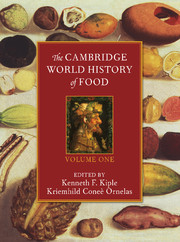Book contents
- Frontmatter
- Introduction
- Part I Determining What Our Ancestors Ate
- Part II Staple Foods: Domesticated Plants and Animals
- II.A Grains
- II.B Roots, Tubers, and Other Starchy Staples
- II.C Important Vegetable Supplements
- II.D Staple Nuts
- II.E Animal, Marine, and Vegetable Oils
- II.F Trading in Tastes
- II.G Important Foods from Animal Sources
- II.G.1 American Bison
- II.G.2 Aquatic Animals
- II.G.3 Camels
- II.G.4 Caribou and Reindeer
- II.G.5 Cattle
- II.G.6 Chickens
- II.G.7 Chicken Eggs
- II.G.8 Dogs
- II.G.9 Ducks
- II.G.10 Game
- II.G.11 Geese
- II.G.12 Goats
- II.G.13 Hogs (Pigs)
- II.G.14 Horses
- II.G.15 Insects
- II.G.16 Llamas and Alpacas
- II.G.17 Muscovy Ducks
- II.G.18 Pigeons
- II.G.19 Rabbits
- II.G.20 Sea Turtles and Their Eggs
- II.G.21 Sheep
- II.G.22 Turkeys
- II.G.23 Water Buffalo
- II.G.24 Yak
- Part III Dietary Liquids
- Part IV The Nutrients – Deficiencies, Surfeits, and Food-Related Disorders
- References
II.G.8 - Dogs
from II.G - Important Foods from Animal Sources
Published online by Cambridge University Press: 28 March 2008
- Frontmatter
- Introduction
- Part I Determining What Our Ancestors Ate
- Part II Staple Foods: Domesticated Plants and Animals
- II.A Grains
- II.B Roots, Tubers, and Other Starchy Staples
- II.C Important Vegetable Supplements
- II.D Staple Nuts
- II.E Animal, Marine, and Vegetable Oils
- II.F Trading in Tastes
- II.G Important Foods from Animal Sources
- II.G.1 American Bison
- II.G.2 Aquatic Animals
- II.G.3 Camels
- II.G.4 Caribou and Reindeer
- II.G.5 Cattle
- II.G.6 Chickens
- II.G.7 Chicken Eggs
- II.G.8 Dogs
- II.G.9 Ducks
- II.G.10 Game
- II.G.11 Geese
- II.G.12 Goats
- II.G.13 Hogs (Pigs)
- II.G.14 Horses
- II.G.15 Insects
- II.G.16 Llamas and Alpacas
- II.G.17 Muscovy Ducks
- II.G.18 Pigeons
- II.G.19 Rabbits
- II.G.20 Sea Turtles and Their Eggs
- II.G.21 Sheep
- II.G.22 Turkeys
- II.G.23 Water Buffalo
- II.G.24 Yak
- Part III Dietary Liquids
- Part IV The Nutrients – Deficiencies, Surfeits, and Food-Related Disorders
- References
Summary
The Dog as Human Food
The difficulty that confronts one at the very beginning of a study of the dog as human food is the lack of convincing evidence relating to the use of dogs (Canis familiaris) as food by early humans. Most of the discussions in published articles are either speculative or employ relatively recent evidence of dog consumption and extrapolate these data to the distant past.
There are some fine published discussions that relate to the eating of dogs in more recent times. One of the best is by Margaret Titcomb (1969), who documents the importance of the dog to human cultures in the ancient Pacific area. Titcomb believes (as do I) that the dog of the Pacific Islands was originally carried by canoe from the Asian mainland along with the pig and chicken for food on the voyage.
It was fed carefully upon vegetables such as taro and breadfruit so that its flesh was palatable to its human owners. Captain James Cook noted in his journal of 1784 that dogs were fed and herded with the hogs. Titcomb (1969) relates that they were fattened on poi and that an informant remembered that relatives penned up puppies to keep them from eating unclean food. They were fed three times a day on poi and broth until fattened. Natives considered baked dog a great delicacy, but they never offered it to foreigners, who held dog meat in great abhorrence, according to the wife of a missionary in 1820.
Preparation of dogs as food is abstracted by Titcomb (1969), who writes:“Like the pig, the dog was killed by strangulation in order not to lose the blood. The blood was poured into a calabash (gourd) used for cooking, and red hot stones were added, causing the blood to coagulate; it was then ready to eat.” The meat might be baked or cut up and wrapped in ti leaf bundles and cooked in boiling water. An informant stated that the upper part of the backbone was preferred by many diners, although some liked the ribs best, and others preferred the brain. The latter has been attested to by dog skulls, with holes in the crania, found in archaeological excavations.
- Type
- Chapter
- Information
- The Cambridge World History of Food , pp. 508 - 517Publisher: Cambridge University PressPrint publication year: 2000
References
- 2
- Cited by

